
About Andrew Cusack
 Writer, web designer, etc.; born in New York; educated in Argentina, Scotland, and South Africa; now based in London.
Writer, web designer, etc.; born in New York; educated in Argentina, Scotland, and South Africa; now based in London. read more
News
Blogs
Reviews & Periodicals
Arts & Design
World
France
Mitteleuropa
Knickerbockers
Argentina
The Levant
Africa
Cape of Good Hope
Netherlands
Scandinavia
Québec
India
Muscovy
Germany
Academica
Poor Old Bram
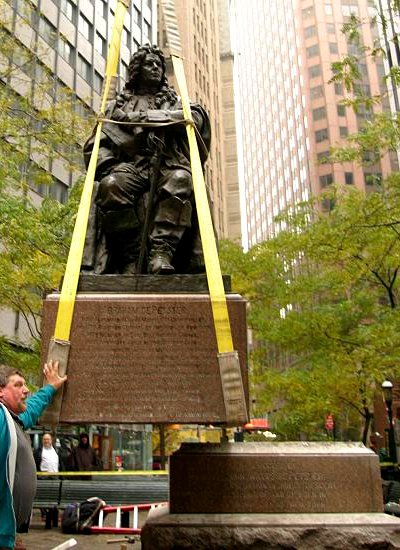
ONE HAS TO FEEL A certain amount of sympathy poor old Abraham de Peyster. The city fathers, in their infinite and unending wisdom, sought fit to erect a statue of Bram in Bowling Green, the old town square of New York down at the beginning of Broadway, many moons ago. However, having set Bram very nicely upon that green, the first public park in all New York, the city fathers have of late refused to let old Heer de Peyster rest. In 1972, the park was ‘renovated’ which entailed the statue’s forced removal. He ended up four years later in Hanover Square, a quite suitable though less prominent location, where he gazed across the square towards India House. It was then that old rivalries flared anew.
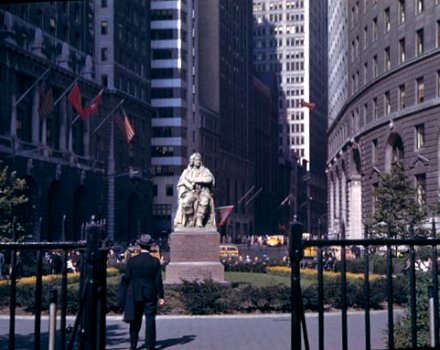
The good old days in Bowling Green.
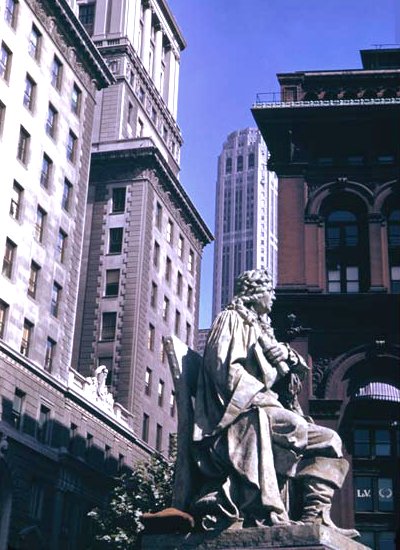
In a situation quite similar to that of the Year of Our Lord Sixteen-Hundred-and-Sixty-Four, when New Amsterdam became New York at the sight of English warships in the Bay, the British began eyeing old Bram’s place of comfort, and they wanted it for themselves. Poor Old Bram could only sigh as the city fathers decided to move him yet again, this time to make way for the British Memorial Garden. As a consolation, however, it has been decided to move him to a place of greater prominence, namely City Hall Park, or ‘the Commons’ as it was known in de Peyster’s day. He has taken advantage of the move to go on holiday though, as he currently sits on Randalls Island enjoying a little rest, relaxation, and refurbishment. We look forward to his arrival at City Hall, and hope they give him a good spot. Still one can’t help but think he’d prefer to be back in Hanover Square, where he could keep to himself with naught but a few bankers and businessmen to bother him, and he could peacefully watch the old men slipping in and out of India House for luncheon.
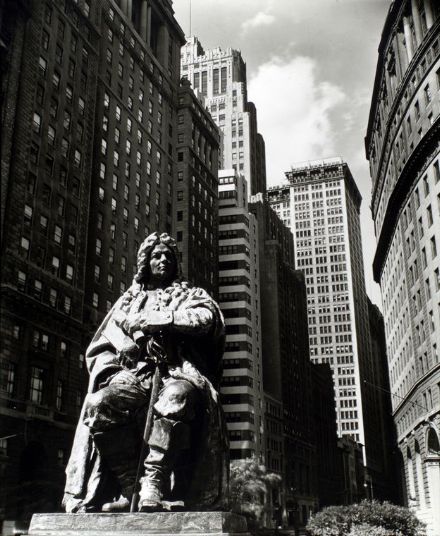
Berenice Abbott took this famous photo of de Peyster in Bowling Green.
Who was the old codger, you ask? De Peyster was born in old New Amsterdam, but spent nine years working on the family farm in the old Netherlands. He returned in 1684 to what had already become New York, becoming a loyal British subject and a prominent citizen of the Province. He was of a thriving mercantile clan, and any significant position which existed in the colony, it was more than likely that Abraham de Peyster held it at one time or another. He was an alderman, mayor of the city, colonel of the militia, member of the King’s Council (the upper chamber of New York’s provincial legislature), and even acting governor at one point. De Peyster was a wealthy man, and founded a New York dynasty. It was his great-great-great grandson, one John Watts de Peyster, who commissioned the statue of the ancient patriarch from the American sculptor George Edwin Bissell. Bissell depicted de Peyster “sporting a lavish cloak, wig, army boots, and sword in hand denoting his political and military roles in the colonial government”. De Peyster was quite proud of his swords, leaving his favorite to his eldest son and dividing the rest among his descendants. The de Peysters are still around, actually, though I suppose it depends on your definition of ‘around’; I believe they are currently based way down in Palm Beach.
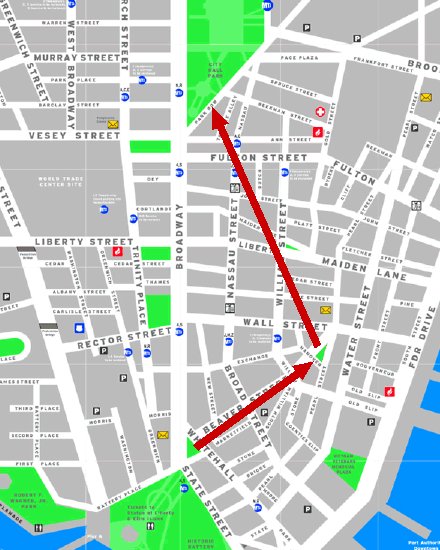
De Peyster’s journey from Bowling Green to Hanover Square to City Hall Park (not including refurbishing sidetrip to Randall’s Island).
Search
Instagram: @andcusack
Click here for my Instagram photos.Most Recent Posts
- Burns Tower April 19, 2024
- Patrick in Parliament March 18, 2024
- Articles of Note: 13 March 2024 March 13, 2024
- Cambridge March 9, 2024
- Taken on Trust March 4, 2024
Most Recent Comments
Book Wishlist
Monthly Archives
Categories



I find it ironic that the Brits kicked old Abe off his pedestal. He’s a distant ancestor. So distant that none of the wealth came my way. Of course, most of his sons were Loyalists (i.e. Tories), their property was confiscated at the end of the Revolution and they took up residence in Cananda. So their fate was much the same as the Iroquoi. The ancestors who share my surname were rebels for the most part. Many of them took advantage of the lands in western New York confiscated from the Iroquoi. So it evens out I guess.
George Cushing , I have some history for you! Can you say that those 4 daughters,Catherine, Margaret , Elizabeth, and Sarah Dupeyster , who were owed 200 pounds in May 3 , 1760 by Arthur(1718)VanKirk, of Cranbury ,New Jersey were daughters descending from a son , or grandson of this Abraham Depeyster , and if so, which one ? It appears as though this Elizabeth was that Elizabeth(1711-1779)Dupeyster who married Hendrick (1712-1779)Rutgers ? Can you imbellish this ? Those Dupeysters do connect in Cranbury New Jersey history of my 5 Applegate brothers history that I have written !Just how was it that Arthur (1718)VanKirk of Cranbury connected with those 4 Dupeyster sisters in 1760 and were they in Cranbury , or in New York City , or where , when it appears as though they loaned 200 pounds to Arthur sometime before 1760.